| About the palace built on the Tigris for the Sasanian king Khosrow II-Parviz (591-628), Edward gibbon tells us with relish, "the adjacent pastures were covered with flocks and herds: the paradise or park was replenished with pheasants, peacocks, Ostriches, roebucks, and wild boars; and the noble game of lions and tigers was sometimes turned loose for the bolder pleasures of the chase. Nine hundred and sixty elephants were maintained for the use or splendor of the Great King; his tents and baggage were carried into the field by twelve thousand great camels and eight thousand of a smaller size; and the royal stables were filled with six thousand mules and horses, among whom the names of Shabdiz and Barid are renowned for their speed or beauty." Such extravagance-and the park and animals occupied only a small part of Gibbon's inventory - entranced Western orientalists of eighteenth and nineteenth centuries, as did the
four-hundred-year rule of the Sasanians themselves. Here were native sons who restored the vanished glories of the Achaemenians after centuries of foreign occupation.
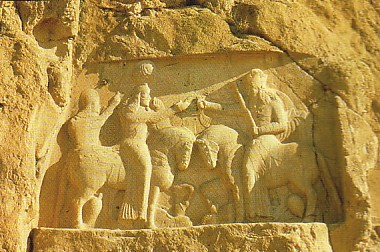
Ardeshir I at Naqhsh-e
Rostam
Following Alexander's death in 323 B.C., Iran had fallen into the hands of his generals, the Seleucids (317 B.C. - A.D. 138). This
period of Hellenism came to an end with the rise of the Parthians from Partowa in northeastern Iran, who drove out Anticochus IV, the last of the Seleucid rulers, and founded their own dynasty, that of the Arsacids. Inhabitants of the region of Khorasan, the Arsacids had their own architectural styles. They built important cities like the Ctesiphon beside the Tigris, Dura-Europos beside the Euphrates, and palaces such as Kuh-e Khawje, Hatra, and
Assur.
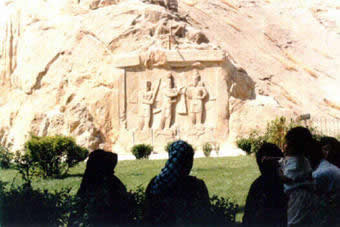
Tagh-e Boustan
Parthian art gradually emancipated itself from the influence of Hellensim; it is an art of transition, a passage form the Greco-Iranian to the neo-Iranian. Parthian palaces like those of the Achaemenians, were built on large artificial terraces surrounded by gardens and parks. It is to the Parthians, however, that we owe the invention of the iwan, an architectural element brought from Khorasan to Mesopotamia: a high room covered by a barrel vault opening to the outside and the gardens.
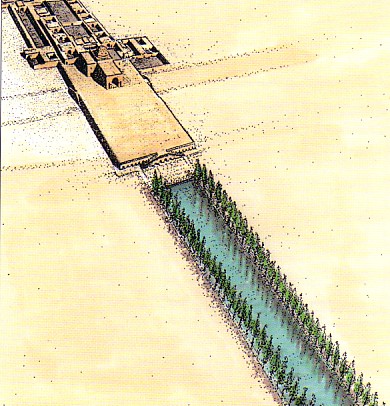
A perspective of Emarat-e
Khosrow complex
The Sasanians fully realized the iwan and perpetuated its use; some still exist today. This high-arched room open to the outdoors was a transitional space like the colonnaded porches of the Achaemenians, but grander and airier. And the Sasanians were the first to exploit the squinch, a simple arch placed at the angles where walls met in a square building that distributes the weight of a superstructure. Without this arch, a building cannot support a dome.
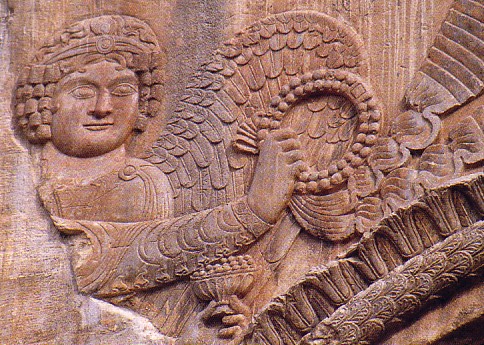
Winged goddess of
victory on the large iwan at Taqh-e Bostan
These innovations were to determine the character of the palaces and mosques of Islamic Persia. They are first seen in the remains of the palaces of the Sasanian kings, the earliest being the third-century residence of Ardeshir I on the Plain of Friuzabad in Fars, a colossal assemblage of iwans and domed halls, raised on a terrace 180 by 340 feet and sited near a natural spring, which, Arab historians record, was diverted to water channels for the
king's park. By the banks of the Tigris to the south at Ctesphon lay the complex attributed to Khosrow I, set in the midst of a walled deer park. What remains is the taq-e Kasra, an elliptical arch soaring 120 feel above the ground that covered the king's audience hall, where his famous carpet lay.
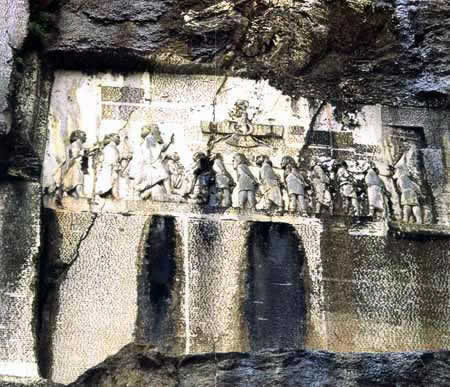
Bisotoon
Other Sasanian palace and garden ruins are similar - meager memories of enormous buildings. Not far from Kermanshah is Taq-e Bostan, with its crystalline spring and its famous grottoes, carves with images of a royal hunt. In the western foothills of the Zagros lie Emarat-e Khosrow and Hawsh-Kuri, palaces built by Khosrow II as retreats for his favorite, "sweet, beloved Shirin the Christian"; according to Arab historians, they lay in a three-hundred-acre walled paradise, overlooked by arcaded passages and cool rooms. Yaqut, the thirteenth-century Byzantine historian, called the latter "one of the wonders of the world."
Baghastana (Sacred Mountain), today called Behistun or Bisotun, is located twenty miles east of the city of Kermanshah. A huge mass of rock encompassing a large "paradise garden" and a perpetual spring, it remains today a historic landmark. Behistun was located on the road from Babylon to the Median capital Ecbatans and on to Raghes (Rey), the great city on the silk Route.
Used since prehistoric times, the site witnessed the passage of the Assyrians, the Achaemenians, Alexander, the Parthians, the sasanians, the Arab invaders, and finally the Mongols; the
remains of caravanserais are found there, the oldest dating from 522 B.C. At the foot of this mountain gushed the clear water of a large, deep spring, which poured into a sacred lake; that was the principal attraction of the site.
The Sasanian kings left another legacy, in their religion. To link themselves with the Achaemenians, they revived the beliefs of the past and established them as the state religion. This religion had undergone a number of changes over the centuries, but it evolved under its famous prophet Zarathustra, better known by the Greek form Zoroaster, it achieved a philosophical sophistication well in advance of its time and extremely influential after it.
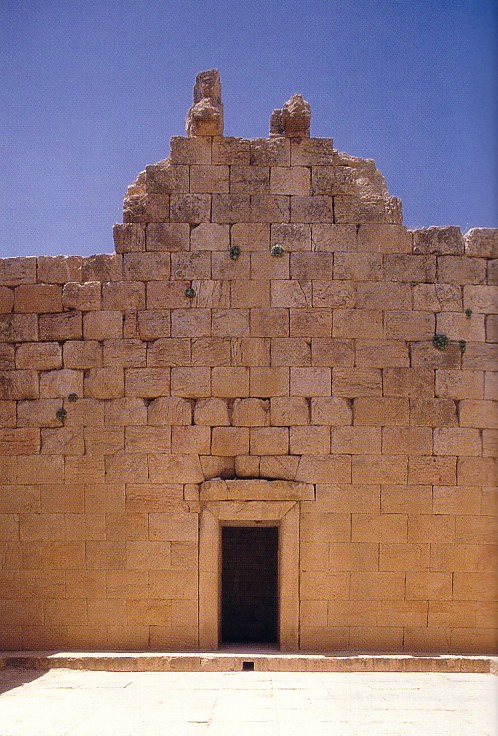
A view of
Anahita's temple at Bishapur
Their religion, so rigid and hierarchical that it gave little comfort to the mass of people, along with exhaustion brought about by continual war with Byzantium and financial depletion from the
extravagances of the late Sasanians, were among the many factors that made the Sasanian Empire susceptible to the armies of Arabia. The beginning of the end, according to Gibbon, came with a letter to Khosrow II: "While the Persian monarch contemplated the wonders of his art and power," we are told, "he received an epistle from an obscure citizen of Mecca, inviting him to acknowledge Mohammad as the apostle of God. He rejected the invitation and tore the epistle." The palace at Ctesiphon and its treasure fell to the armies of Islam in 637, the remains of the Iranian armies were defeated in 641, and the last Sasanian king, Yazdegerd III, a fugitive, was murdered at Marv in 651.
The Sasanians were the last heirs of western Asia, and their art, though purely Iranian, penetrated beyond political borders and left its mark on the arts of their neighbors and through them on that of the world at large. It was at Ctesiphon, which the Arabs later called Madain (The Cities), that the conquerors came to know and admire Sasanian art. The site, the gardens, the palaces decorated with great refinement, and the
exquisite carpets covering the floors appealed to their imagination, Ctesiphon made them gain an insight into Persian
culture.
When the palace of the new governor of Kufa was rebuilt in 670 , it was called Dar Al-Imara. A strictly axial building, it was the first Arab residence built in a style resembling the architecture of Sasanian palaces. The caliphs started building highly designed houses and gardens in the style of Sasanian complexes. The palace and gardens of Jawsaq el-Khaqani at Samrarra, built by the caliph Al Mu'tasim (833-842) on the banks of the Tigris, serve as an example. It is a vast complex surrounded by a turreted wall and recalls the two Sasanian palaces of Qasr-Shirin.
At the far end of the Islamic world, in Spain, one of the Umayyad
caliphs had a palace and gardens built near Cordoba, to commemorate his beloved, Zahara. About this palace, Alan Colin wrote, "The Medinat Al Zahara is an example of a contemplation center on the model of the gardens of the Iranian east."
In Persia itself, the first national and Muslim dynasty was that of the Buyids. They began to govern the west of the
country in 933. Azod al-Dowleh, the most brilliant among their sovereigns, had himself called
Shahanshah in Persian and Malik al-Muluk in Arabic (both meaning king of kings). He established his Iranian capital in Shiraz and had his palace and gardens built outside the city. According to Muqqdassi, the tenth-century Arab geographer, this royal residence was
situated amid "bostan," a Persian word meaning flower garden, adopted by the Arabs to describe gardens in the Iranian style. Later on, the Pahlavi word bagh
reappeared and was commonly used to refer to a garden with the accession of the
Saljuqs.
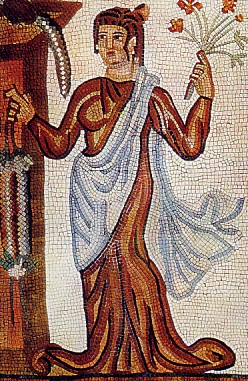
Third century floor
mosaic from the palace of Shapur I depicting a woman holding a
bouquet of flower
Malek Shah, one of their sovereigns, had a set of four gardens planted in his new capital, Isfahan, in the late eleventh century. These gardens covered an area of four thousand Jarib (a jarib is about 2 1/2 acres) and were called Bagh-e Karan, Bagh-e Fallasan, Bagh-e Bakr, and Bagh-e Ahmad. The most spectacular of them was the first. It had two residences, one opening onto the river (the Zayandeh Rud), the other facing the great city square. Both overlooked the park which connected them. Lotfollah Honarfar observed, several contemporay poets , including Hafez, paid tribute to the beauty of these gardens.
|